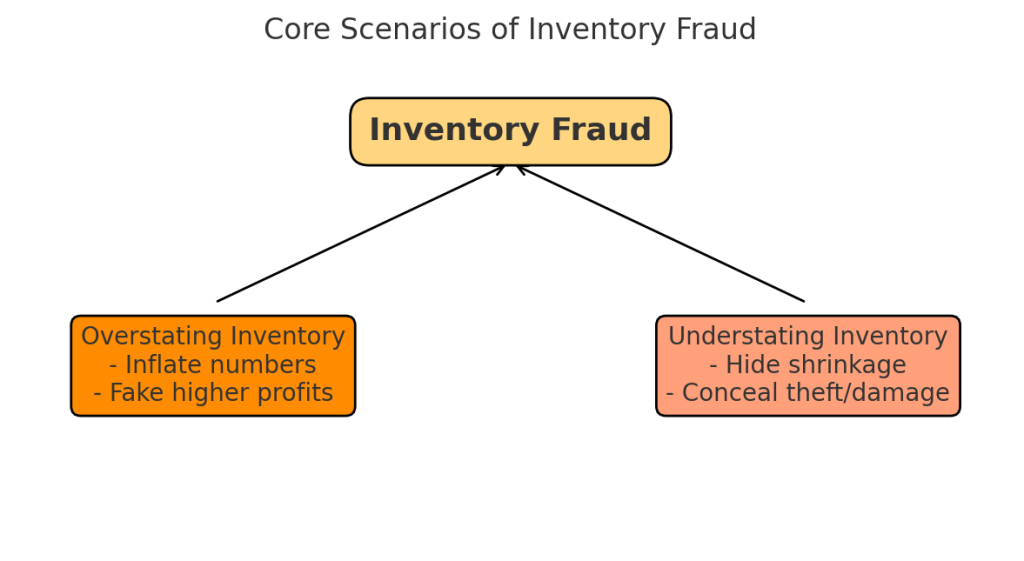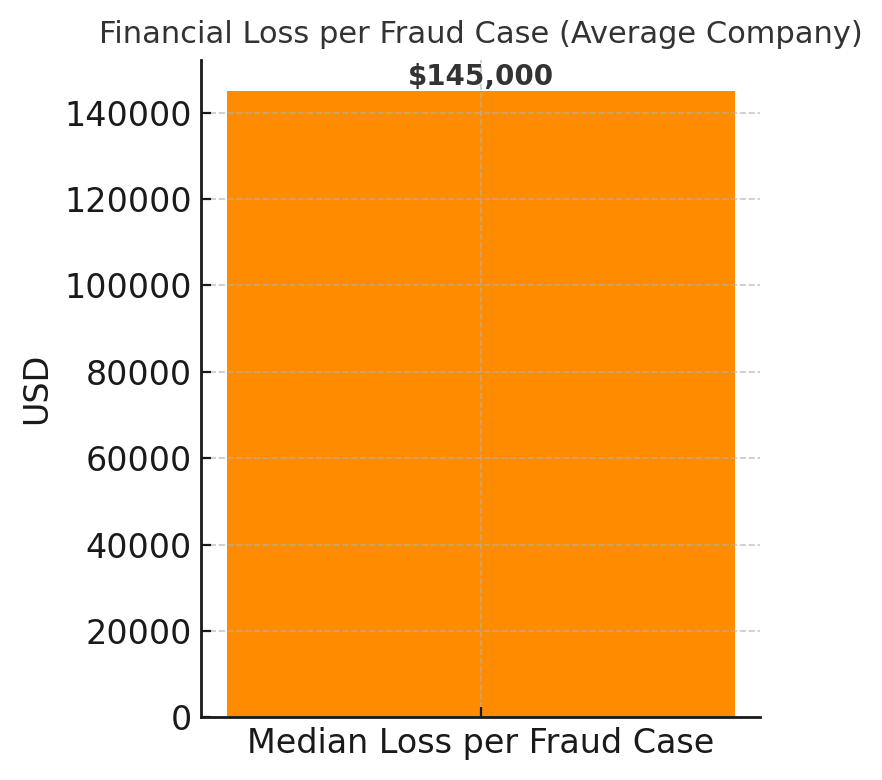Inventory fraud might not make headlines as often as embezzlement or identity theft, but its impact on businesses, especially in retail, logistics, and manufacturing, is just as severe. Fraud in inventory can quietly eat away at your profits and damage operational efficiency before you even realize it.
In this article, I’ll provide insights into what inventory fraud is, how inventory fraud can occur, case references to the real world concerning inventory fraud, and most importantly, how to keep your business safe from it.
Inventory fraud is defined as intentional manipulation or misrepresentation about inventory records such that it deceives interested stakeholders or acts to conceal loss, theft, or inaccuracies. Such fraud can occur by both employees, suppliers, or customers, and most often tie to a weak internal control and lack of supervision.
At the core, inventory-related fraud will and probably always will fall into one of two principal scenarios:

Inventory fraud isn’t just a back-office problem, it can quietly erode your business across finances, operations, and brand trust. Here’s how.
These are inventory frauds intended to deviate from accurate financial reporting, affect the company’s profitability, and cleanse the resources. For an average company, employee fraud is assumed to take about 5% of its annual revenue, with the median loss per fraud case pegged at $145,000, according to the Association of Certified Fraud Examiners (ACFE).

Retail, however, holds a more alarming cost. A report from Forbes stated that inventory shrinkage accounted for $46.8 billion in losses for U.S. retailers in 2019, considering theft, fraud, and administrative errors.
These figures represent not only monetary losses but also as a wish list for the worst kind of scenario: unchecked fraud.
When inventory records are inaccurate due to fraud, day-to-day operations become unpredictable. Stockouts, overstocking, and delayed order fulfillment all stem from bad data. This disrupts supply chains and throws off demand forecasting.
Worse yet, resolving fraud-related issues consumes valuable time and labor. Instead of focusing on growth or strategy, your team is stuck fixing what went wrong, again.
Fraud also affects the one thing money can’t easily fix: your reputation. Customers expect reliable service and accurate fulfillment. When fraudulent inventory practices lead to delays or errors, trust erodes quickly.
In competitive markets, even one bad experience can trigger poor reviews, lost sales, and long-term damage. And if fraud becomes public, through lawsuits or media coverage, it doesn’t just hurt your reputation; it scares away future business.
Inventory fraud can manifest in subtle ways, often blending into routine operations. Here are the most common forms to watch out for:
| Type of Fraud | Description | Inventory Fraud Examples |
|---|---|---|
| False Stock Takes | Inflating or reducing inventory counts during audits to cover up losses or errors. | A worker reports 1,200 units when only 900 exist. |
| Inventory Shrinkage Fraud | Misreporting theft, damage, or loss to meet targets or avoid scrutiny. | A manager hides 4% shrinkage by reporting just 1%. |
| False Receiving Documentation | Marking undelivered or incomplete goods as received in the system. | An order shows 100 units received, but only 70 arrived. |
| Physical Theft of Inventory | Stealing physical stock without logging or authorization. | An employee quietly removes items from storage. |
| Falsifying Perpetual Records | Editing digital records to hide discrepancies in real-time systems. | The inventory system shows 500 units; the actual stock is 350. |
| Skimming During Transfers | Siphoning off items during stock transfers while reporting full delivery. | 20 units go missing during transfer, but 100 are logged. |
While some cases are driven by malicious intent, many happen simply because systems make it easy, or at least easy enough to get away with. That’s why prevention matters just as much as detection. Below are five practical, proven ways to protect your inventory and bottom line.
Good inventory hygiene starts with strong internal controls. One of the most effective strategies is segregation of duties, ensuring that no single employee handles the entire inventory process from start to finish. For instance, the person who receives stock shouldn’t be the same one who logs it or performs audits.
When responsibilities are shared across multiple roles, it becomes harder for any one individual to manipulate records or cover their tracks. You should also implement role-based access controls in your inventory system to prevent unauthorized adjustments or backdated changes.
Audits are your reality check. Regular inventory audits help you track discrepancies over time, but unscheduled, random audits are where you truly catch fraud in action. They create an environment where employees are always accountable, not just during scheduled reviews.
Moreover, physical stock counts should be routinely compared with system records. Even a small recurring mismatch is worth investigating, as it may point to a broader issue in procedures, or something more serious.
Technology does not eliminate fraud, but it certainly makes it much harder to cover up. A solid inventory management system will provide real-time tracking, automatic alerts for discrepancies, comprehensive audit logs, and multi-user access control. Such an infrastructure ensures that all the actions are auditable and visible.
Beyond tracking, means like barcode scanning and RFID further combat human error and increase accountability. If you arm your system with technology, you would minimize manual reliance and establish the digital trail which will dissuade any tampering.

Even the best systems can fail if your team doesn’t understand them, or worse, doesn’t care. That’s why ongoing employee training is critical. Staff should know not only how to follow procedures, but why they exist in the first place.
Regular workshops or refreshers on fraud risk, red flags, and ethical expectations create a culture of awareness. People are far less likely to commit fraud, or ignore it, when they clearly understand its impact on the business and their role within it.
Fraud thrives in silence. To deter it, foster a workplace culture where speaking up is not just accepted but encouraged. Employees should be encouraged to confidentially report dubious events by way of a protected mechanism, with no fear of retaliation.
This may include a whistleblower hotline, offering protection policies, or embedding it into a team culture that normalizes open dialogue during regular team check-ins.
Blocking suspicious IP addresses is a frontline defense against bad actors. These include users coming from VPNs, proxies, or high-risk countries often linked to fraudulent behavior. By filtering traffic early, you stop bots and scrapers before they can inflate demand or exploit your stock.
This method is especially helpful for flash sales or limited-stock items, where inflated traffic from fake users could lead to sell-out fraud or stock manipulation.
High-value or frequently targeted products deserve an extra layer of protection. Add security checks at checkout, such as phone or email verification, and use fraud detection tools to analyze the risk level of each order in real time.
You can also limit the quantity per purchase or flag unusual behaviors like mismatched billing and shipping details. These safeguards keep your inventory protected while letting legitimate customers buy without friction.
According to The Nation, in the early 2010s, Walmart faced serious accusations from former employees who claimed that the company engaged in inventory manipulation to artificially reduce reported shrinkage. Shrinkage refers to the loss of inventory due to theft, damage, or clerical errors, and keeping it low was tied to management performance goals.

Former regional manager Vikki K. Gill revealed that store managers were pressured to meet unrealistic shrinkage targets. As a result, some allegedly resorted to falsifying inventory records, adjusting numbers on paper to make the stock levels look healthier than they actually were. This form of inventory manipulation helped stores appear more profitable while hiding operational issues.
Several ex-managers shared similar claims, suggesting that the issue may have been systemic rather than isolated. While Walmart denied the allegations, the reports raised concerns about internal pressure and flawed performance incentives tied to inventory.
While internal controls and audits are essential, using the right tools makes a huge difference. Blockify helps merchants stop fraud before it happens, right at the storefront level.
With features like IP and country blocking, Blockify prevents suspicious visitors (VPNs, proxies, TOR users) from ever reaching your store. Its auto-cancel for high-risk orders and Fraud filters ensure that fraudulent purchases don’t mess with your inventory or margins.

You can also block bots, reduce fake traffic, and receive real-time alerts, all through a no-code interface. For added protection, Blockify Checkout screens users at the checkout stage, keeping fraudsters from completing harmful orders.
Simply put, Blockify gives you peace of mind by keeping fraudsters out and your stock safe.
Conclusion
Inventory fraud may start small, yet has contended to grow up fast into a business monster, draining revenue, distorting reports, and eroding trust. Hence, it becomes a key position for any enterprise in its long life to know how it occurs, identify the red flags, and initiate preventive measures.
Tools like Blockify make it that much easier for you to detect and thwart threats before they touch your inventory. From filtering risky traffic to auto-canceling suspicious orders, it’s a smart layer of defense every store needs.
Don’t let inventory fraud sneak in through the back door, stop it before it starts!